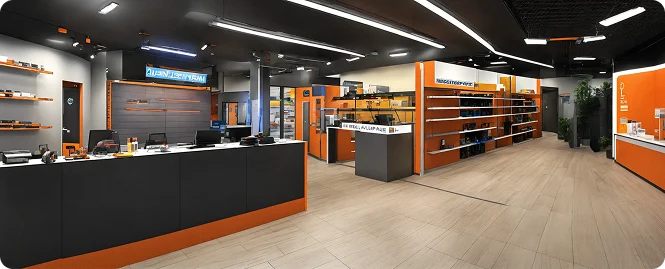How to Open a Convenience Store in Arkansas
Table of Contents
Key Takeaways
-
Arkansas’s convenience store industry is thriving, offering significant opportunities for new and existing business owners.
-
Success begins with thorough market research, identifying ideal locations, and securing necessary legal permits to operate smoothly.
-
A well-structured financial plan, along with strategic equipment sourcing, ensures efficiency and long-term profitability.
-
Hiring skilled employees, providing proper training, and implementing targeted marketing strategies help build customer loyalty.
-
Securing comprehensive insurance from a reliable insurance provider safeguards the business against unforeseen risks, ensuring long-term stability.
In recent years, Arkansas has seen a rising surge in convenience store businesses, driven by increasing consumer demands and urban expansion. Business owners are attracted to this profitable niche as modern retail trends favor quick, accessible shopping experiences. This growth is aided by advancements in point-of-sale systems, advanced security systems, and innovative store designs, making it an ideal time for aspiring store owners to consider this dynamic market with promise for stable growth.
Understanding every step and legal requirement is crucial for anyone looking to open a convenience store in Arkansas. Prospective business owners must deal with business structure decisions, licensing, zoning laws, and permits such as those issued by the Secretary of State. A thorough comprehension of financing options, profit margin expectations, and long term planning strategies minimizes risks and sets a strong foundation. In this blog, we’ll go over steps to open a store in Arkansans.
Step 1: Researching the Market and Location
Selecting the right location is vital when opening a well-stocked store in Arkansas. Consider areas with high foot traffic near residential neighborhoods and busy intersections. An ideal spot should be easily accessible, visible from main roads, and offer ample parking, guaranteeing customer convenience and boosting local market presence for success.
Assessing the local competitors is essential when opening a store in Arkansas. Check out existing grocery store and convenience store businesses to understand their offerings, pricing, and service quality. Observe consumer behavior and preferences in the area to identify gaps and opportunities that can set the store apart for maximum growth.
Several factors must be considered when selecting a high-traffic area for your convenience store. Evaluate neighborhood demographics, nearby businesses, and pedestrian flow patterns. Consider accessibility by public transport and vehicle traffic. A well-chosen location can significantly improve profit margins, support long-term growth, and also attract a diverse range of customers.

Step 2: Business Plan Development
Developing a detailed business plan is critical when deciding to open a convenience store in Arkansas. Outline your vision, mission, and operational strategy clearly. Include analysis of market trends, competition, and potential revenue streams. A comprehensive plan not only guides your actions but also instills confidence in lenders and investors.
In your business plan, clearly outline your store’s goals, the range of services offered, and projected financial outcomes. Detail startup costs, ongoing expenses, and expected profit margins. This thorough financial roadmap assists business owners in planning capital needs, setting realistic benchmarks, and effectively measuring progress against set objectives over time.
Define your target customer base by assessing local demographics and consumer preferences. Identify key segments that frequent convenience stores in Arkansas. Build comprehensive marketing strategies that relate to community needs, incorporate digital promotion, and leverage social media. Personalize your messaging to highlight benefits, affordability, and convenience to attract loyal customers.

Step 3: Legal Requirements and Permits
Understanding the necessary insurance regulations, licenses, and permits is a critical step for opening a convenience store in Arkansas. Research state and local regulations to determine which permits are required. This includes health department approvals, business licenses, and permits for selling tobacco products and alcoholic beverages, ensuring legal compliance from day one.
Local zoning laws play an essential role in determining where you can open a convenience store in Arkansas. Check with municipal planning departments to understand restrictions and requirements. Ensure your chosen location meets zoning criteria, occupancy limits, and signage rules to avoid legal complications and start smoothly for your business.
Register your business with the Arkansas Secretary of State to ensure proper legal standing. Complete all necessary documentation and file required forms accurately. In addition, obtain a sales tax permit from local authorities. This official registration establishes your store’s legitimacy and shows the way to smooth financial operations without delay.
.webp)
Step 4: Securing Financing
Securing financing is a critical phase when opening a convenience store in Arkansas. Explore various financing options, including bank loans, private investors, and personal savings. Consider applying for support from the Small Business Administration to access grants and low-interest loans. A well-prepared financial strategy that outlines startup costs, cash flow projections, and profit margin expectations can significantly boost confidence among lenders and set the stage for long-term business success, ensuring sustainable future growth.
Prepare detailed financial documents and compelling presentations to impress potential lenders when opening a convenience store in Arkansas. Include balance sheets, income statements, and cash flow forecasts that clearly illustrate expected returns. Organize all records properly and practice your pitch to explain your business plan confidently. Highlight your profit margin projections, cost management strategies, and market research data, which collectively demonstrate your readiness to start a business and sustain long-term operations for maximum impact.

Step 5: Choosing the Right Store Format
When choosing a store format, check the benefits of an independent convenience store versus a franchise model in Arkansas. An independent store offers flexibility in operations and creative control, while a franchise provides brand recognition, established procedures, and marketing support. Evaluate factors such as initial investment, ongoing fees, and potential profit margin. Consider your experience and long-term business goals to make an informed decision that aligns with your vision as a convenience store owner.
Both independent stores and franchises have distinct advantages and drawbacks. While independence allows for greater customization and potential profit margin, franchises offer a proven business model and ongoing support. Assess the trade-offs by considering brand strength, operational freedom, and cost implications. Conduct thorough market research and consult with experienced business owners. Ultimately, choose the option that best suits your financial capabilities, risk tolerance, and vision for long-term success after carefully evaluating and going through alternatives.

Step 6: Store Design and Layout
Designing the interior layout of your convenience store is essential for maximizing efficiency and enhancing customer experience. Plan a layout that optimizes product placement, minimizes congestion, and facilitates smooth traffic flow. Consider incorporating modern point-of-sale systems and secure shelving units for merchandise. A well-thought-out design improves operational efficiency and creates an inviting atmosphere that encourages repeat visits and supports long-term profitability for your store to drive consistent customer loyalty.
Effective product placement is key to maximizing your store’s sales space. Arrange items strategically by placing high-demand products at eye level and impulse buys near checkout areas. Utilize signage, lighting, and organized shelving to highlight promotions and special offers. Consider customer flow patterns and adjust the layout to reduce clutter. Thoughtful placement can boost sales, enhance the shopping experience, and contribute significantly to the overall success of your convenience store business with precision.

Step 7: Purchasing Equipment and Inventory
Identify the essential equipment required for your convenience store in Arkansas. This includes reliable cash registers, advanced point-of-sale systems, durable shelving, and efficient refrigeration units. Carefully assess your store layout and inventory needs to determine the best equipment that enhances operational efficiency and supports a simplified retail experience.
Source reliable suppliers for diverse items, including food, drinks, snacks, and other essential items. Establish strong relationships with vendors to secure competitive pricing and consistent product quality. This proactive approach ensures your store remains well-stocked, appealing to customers and maintaining a robust supply chain for smooth operations.
Effective inventory management is crucial for maintaining profitability. Regularly monitor stock levels and implement automated ordering systems to prevent shortages. Analyze sales trends and adjust inventory accordingly. Efficient inventory practices help reduce waste, control costs, and ensure that your convenience store consistently meets customer demand while optimizing storage space effectively.

Step 8: Hiring and Training Staff
Hiring the right employees is fundamental to the success of your convenience store in Arkansas. Look for individuals with strong customer service skills, reliability, and a positive attitude. Conduct thorough interviews and background checks to fit your business culture well. Focus on recruiting staff capable of handling diverse tasks, from operating the point of sale to managing inventory, thereby supporting efficient daily operations and overall store performance with utmost care.
Develop comprehensive employee training programs that emphasize exceptional customer service, accurate cash handling, and adherence to store policies. Provide hands-on training sessions, role-playing scenarios, and clear guidelines to empower your staff. Continuous training not only improves service quality but also enhances operational efficiency. Regularly update training materials to reflect new technologies, updated procedures, and changing market conditions, ensuring your team remains knowledgeable and prepared for every situation. This commitment fosters a professional and motivated workforce.

Step 9: Marketing and Promotion
Develop a robust marketing strategy to attract customers to your convenience store in Arkansas. Identify target demographics and tailor promotions accordingly. Utilize traditional advertising and digital platforms, ensuring your message reaches local communities. A strategic marketing plan effectively builds brand awareness and drives consistent foot traffic into your store.
Implement local advertising campaigns, seasonal promotions, and targeted social media to drive traffic. Engage with community influencers and leverage online reviews to boost your store’s reputation. These promotional tactics enhance visibility, stimulate sales, and build lasting customer relationships in a competitive market for outstanding local impact.
Focus on building strong relationships with the local community through sponsorships, events, and partnerships. Develop loyalty programs that reward repeat customers and encourage word-of-mouth referrals. A personalized approach to customer engagement fosters trust, increases sales, and transforms occasional visitors into loyal, long-term patrons, ensuring sustainable growth and community support.

Step 10: Opening Day Preparations
Begin preparing for the grand opening by finalizing all operational details and promotional plans. Organize a detailed checklist covering inventory, staffing, and store setup. Ensure all permits and licenses are in place. A well-orchestrated opening event creates excitement and draws attention from the local community to guarantee a memorable debut.
Plan a soft opening prior to the official launch to gather customer feedback and refine operations. Invite select community members and local business owners to test the store experience. Use their insights to adjust inventory, improve service, and fine-tune store layout, ensuring a flawless transition to full-scale operations with confidence.
Organize attractive promotions and discounts for the opening day to draw initial customers. Offer special deals on popular items, loyalty rewards, and bundled packages. Leverage social media announcements and in-store signage to highlight these offers. Effective promotions create buzz, encourage trial, and immediately set the stage for ongoing customer engagement.

Conclusion
In summary, opening a convenience store in Arkansas involves extensive market research, a detailed business plan, and careful attention to legal requirements. Securing financing, selecting the proper store format, and planning store design are equally crucial. Each step builds upon the previous one to create a strong foundation for success.
Insurance is vital in safeguarding your convenience store against unforeseen risks—partner with Insure C-Store to find relevant business insurance coverages that protect your assets, employees, and customers. A robust policy minimizes financial setbacks and provides peace of mind, allowing you to focus on confidently growing your business and ensuring consistent long-term stability.

